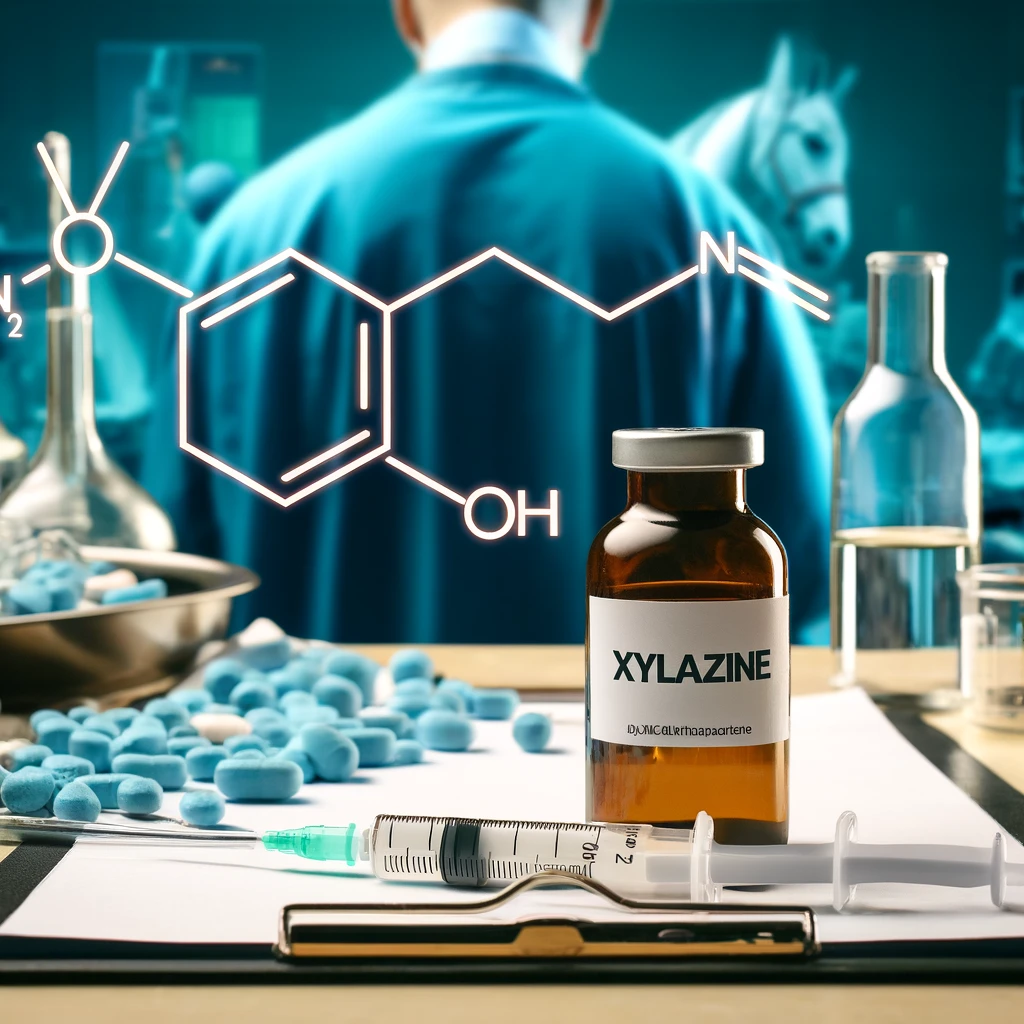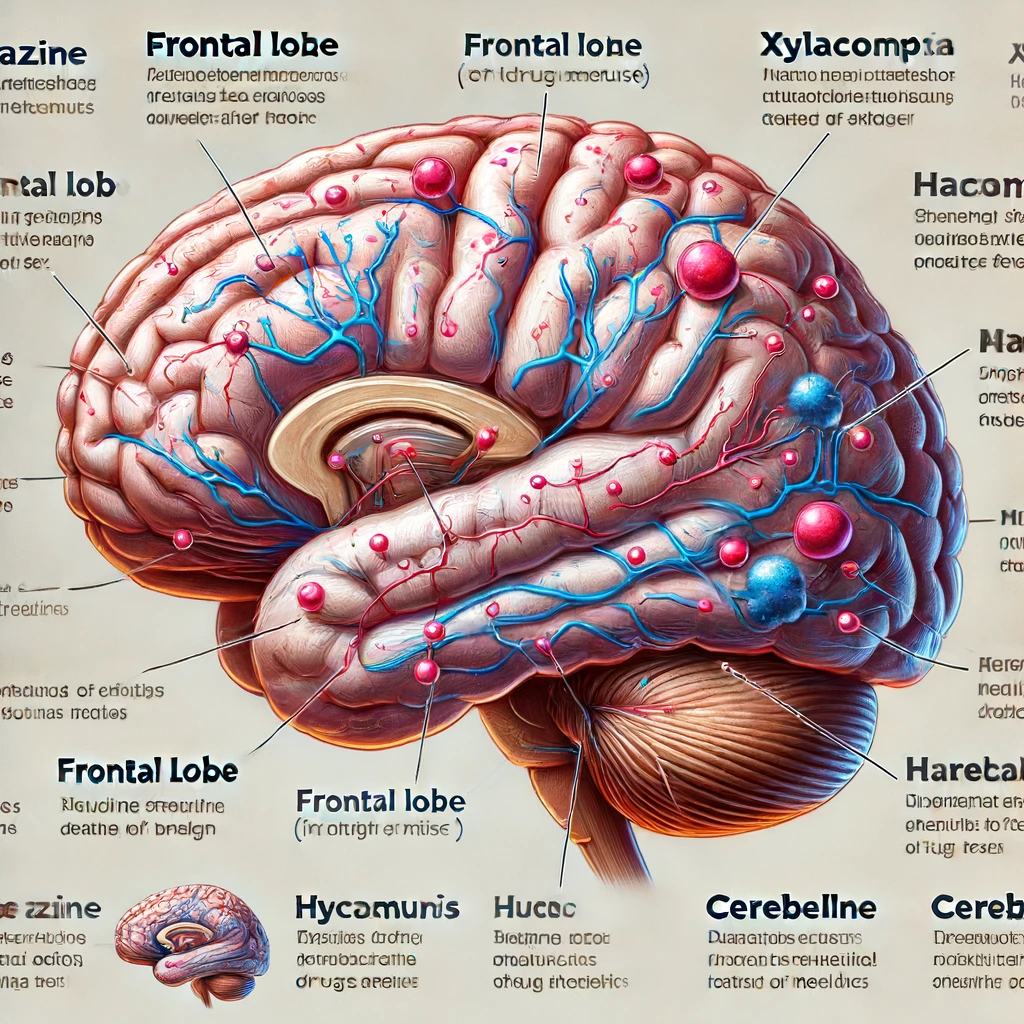Xylazine
What is Xylazine?
Xylazine is a strong veterinary drug used for sedation and pain relief in animals. It works by activating alpha-2 adrenergic receptors in the brain, which inhibit the release of norepinephrine, dopamine, and other neurotransmitters. This mechanism not only results in sedation and pain relief but also significantly depresses the central nervous system. In people, this can lead to respiratory depression, decreased heart rate, lowered blood pressure.
Despite its intended use for animals, xylazine has found its way into the illicit drug market. It was first detected as an adulterant in heroin supplies in Puerto Rico in the early 2000s. Its use as an additive has since spread to the mainland United States, becoming particularly prevalent in cities like Philadelphia by the late 2010s. In recent years, xylazine has been detected in illicit drug mixtures, often combined with opioids like heroin and fentanyl but also cocaine, methamphetamine, and benzodiazepines.
How Do People Use Xylazine?
Xylazine is smoked, injected, snorted, or ingested, with users often unaware of its presence in the drugs they consume. This illicit use greatly heightens the dangers associated with xylazine, as it is not intended or safe for human consumption. Xylazine known on the streets as “tranq” or “tranq dope,” when combined with heroin or fentanyl, has been associated with increased rates of illness, overdose, and death.
Tranq dope has emerged amid the ongoing opioid epidemic, with individuals seeking stronger sedative effects. The sedative effects of xylazine are much stronger and longer-lasting than those of many other central nervous system depressants. Unlike opioids, xylazine carries severe side effects and substantial health risks, contributing to the growing concern about its role in drug abuse and its public health impact.
What Are the Effects of Xylazine?
Xylazine’s growing prevalence as a recreational drug has raised concerns about its impact on the brain and adverse health effects.
Brain Effects include:
1. Depression of the Central Nervous System (CNS)
- Mechanism: Xylazine significantly depresses the CNS by inhibiting norepinephrine release, which is crucial for alertness and arousal.
- Effects: This can lead to severe sedation, disorientation, respiratory depression, low blood pressure, and a decreased heart rate, potentially resulting in a comatose state.
2. Impact on Neurotransmitter Levels
- Norepinephrine and Dopamine: Xylazine’s alpha-2 adrenergic agonist action reduces the release of these critical neurotransmitters, affecting alertness, arousal, attention, memory, reward, and mood.
- Effects: Users may experience profound lethargy, cognitive impairment, and depressive symptoms.
3. Altered Brain Function and Structure
- Prefrontal Cortex: This area, responsible for decision-making and problem-solving, can be impaired, leading to poor judgment and impulsivity.
- Hippocampus: Essential for memory formation, the hippocampus may be impaired, resulting in memory deficits and learning difficulties.
Other health effects include:
The health risks of xylazine in humans are profound and varied, particularly when used illicitly. Adverse effects include:
- Xylazine-induced wounds such as necrotic skin ulcerations, skin abscesses, and potentially limb amputation
- Increased risk of infections due to impaired wound healing
- Potential for fatal overdose, especially when combined with other depressants like fentanyl, heroin, and benzodiazepines
- Neurological effects such as drowsiness, dizziness, and confusion are common.
- Gastrointestinal problems such as nausea and vomiting frequently occur among users.
Is Xylazine Addictive?
While xylazine itself is not classified as an addictive substance, its powerful sedative properties can lead to dependence, especially when combined with other drugs. Users may develop an addiction driven by the enhanced and prolonged euphoric effects of opioids.
The cycle of addiction is further intensified by the need to avoid severe withdrawal symptoms that result from using xylazine with opioids. This hidden danger contributes to the complexity of substance use disorder and the challenges of treatment.
How Is Xylazine Addiction Treated?
Treating xylazine addiction involves addressing both the opioid dependency and the complications arising from their use. Comprehensive addiction care and recovery includes:
- Detoxification: Medical supervision to safely manage withdrawal symptoms.
- Medication Treatment: While specific medications for xylazine addiction are not available, medications like methadone or buprenorphine can help manage opioid withdrawal and cravings when used in conjunction with opioids.
- Behavioral Therapy: Cognitive-behavioral therapy (CBT) and other counseling methods address underlying psychosocial aspects of addiction and promote long-term recovery.
- Wound Care: Treatment for xylazine-induced wounds may involve medication for pain and infections, keeping wounds clean, amputation, and other management modalities as needed.
- Harm Reduction Strategies: Education on safer drug use practices, access to clean needles, and overdose prevention training aim to reduce the health risks associated with drug misuse.
Points to Remember
- Xylazine is a veterinary drug not approved for human use, posing significant health risks.
- Its misuse in humans, particularly in illicit drug mixtures, has become a troubling aspect of the opioid epidemic.
- Health risks of xylazine in humans include severe respiratory depression, cardiovascular issues, neurological effects, and xylazine-induced wounds.
- While not inherently addictive, xylazine contributes to the cycle of drug abuse and dependence on opioid mixtures.
- Effective xylazine addiction treatment requires a comprehensive approach, addressing both opioid dependency and specific complications from their use.
- Public awareness and harm reduction strategies are crucial in mitigating the public health impact of xylazine.
- Ongoing xylazine research is essential to understand its effects fully and develop targeted interventions.
References
- American Academy of Family Practice (AAFP)
- National Institute on Drug Abuse (NIDA) on Xylazine and Drug Abuse
- The New England Journal of Medicine
- Centers for Disease Control and Prevention (CDC) on Xylazine
- National Center for Biotechnology Information

Understanding Xylazine: An Overview
Xylazine is a veterinary drug which acts on the central nervous system by binding to alpha-2 adrenergic receptors, resulting in sedation, muscle relaxation, and analgesia.
In humans, it can cause severe respiratory depression, bradycardia, hypotension, and profound sedation. Chronic use can lead to necrotic skin ulcers and other severe health issues.
Xylazine has been increasingly detected in the illicit drug supply, often mixed with fentanyl but also cocaine, methamphetamine, and benzodiazepines.
The combination of xylazine and fentanyl or benzodiazepines can enhance the sedative effects but also significantly increase the risk of respiratory depression and fatal overdoses.

Xylazine addiction treatment
Treating individuals with xylazine addiction requires a comprehensive approach, including medical detoxification, management of withdrawal symptoms, and addressing any co-occurring substance use disorders.
Harm reduction strategies, such as safe injection practices and wound care, are critical for managing the health impacts.
Struggling with Xylazine?
If you or a loved one is struggling with a Xylazine use disorder, call Solstice Health & Wellness to schedule an appointment, or to learn more about addiction recovery services, contact us.
*Please do not submit any Protected Health Information (PHI).

